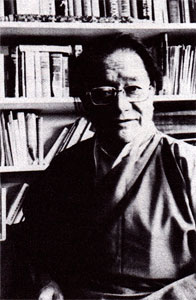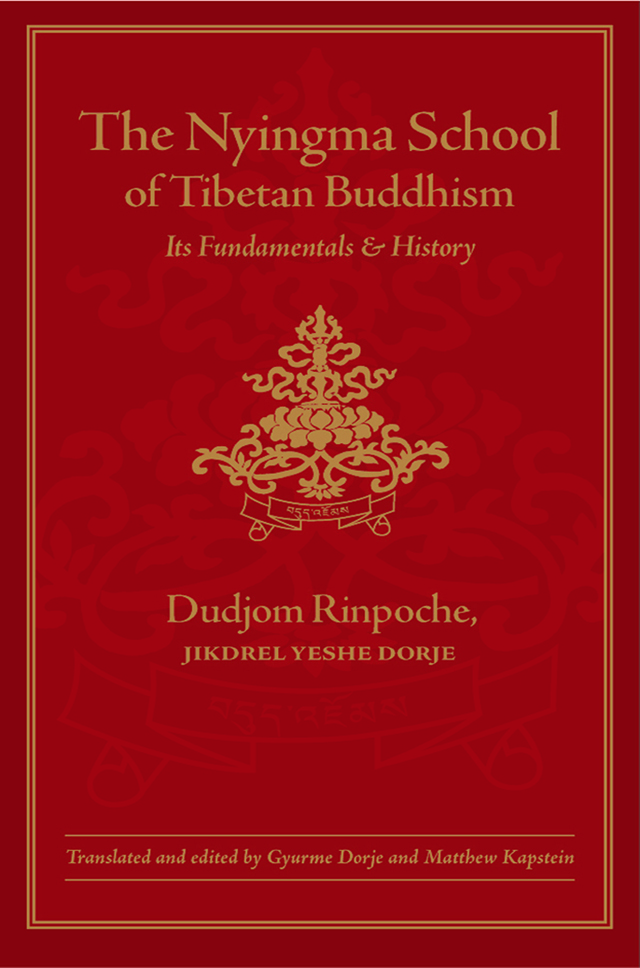The Nyingma School of Tibetan Buddhism
By Dudjom Jigdal Yeshe Dorje
Volume 1: The Translations, 973 pp.
Book 1: Fundamentals of the Nyingma School
Book 2: History of the Nyingma School
Volume 2: Reference Material, 485 pp.
Translated and edited by Gyurme Dorje and Matthew Kapstein.
Wisdom Publications: Boston, 1991.
132 line drawings, 88 color plates, 11 maps, $240 (Boxed set).
Every once in a while there comes a work which, by its breadth of vision and attention to detail, becomes the standard and classic in its field. The Nyingma School of Tibetan Buddhism is such a work. Over twenty years in the making, these two volumes enable students of Tibetan Buddhism to inquire to their hearts’ content into the doctrines and history of the least understood school of Tibetan Buddhism—the Nyingma, or “Ancient Ones.”
These “Ancient Ones” are regarded as preserving the oldest Tibetan Buddhist teachings. Prior to the “new” (gsar-ma) historical revisionism of the early eleventh century, and the rise of the Kadampa, Kagyupa, and Sakyapa schools, there was no division into “old” and “new.” But with the growing influence of the revisionists, many of the esoteric scriptures (tantras) and meditative traditions based upon them, came to be regarded as the old way. This meant that many of the spiritual traditions once regarded by Nyingmapas as emanating from the primordial teacher, the Dharmakaya Buddha Samantabhadra, were now considered by the “new” schools to be fabricated and false. And by the early fourteenth century, we find the compilers of an “official” Tibetan Buddhist canon excluding many Nyingma scriptures.
But the Nyingmas persisted, maintaining their own collections of sacred scriptures and hidden treasures and promulgating what they held to be authentic spiritual teachings via “treasure finders” (those who discover treasures of spiritual import).

To this day the legacy of suppression of Nyingma scriptures as unauthentic and the discounting of treasure finders continue. It was against this historical background that the contemporary Nyingma scholar, dzogchen meditation master, and treasure finder, His Holiness Dudjom Rinpoche Jigdal Yeshe Dorje, composed two influential works on the philosophical coherence and the historical authenticity of the Nyingma. The first volume of The Nyingma School consists of English translations of these two works.
The work on philosophical doctrines, entitled Fundamentals of the Nyingma School, presents a comprehensive account of traditional philosophical views, both secular and religious, non-Buddhist and Buddhist. It also includes an extended discussion of the validity of the esoteric scriptures and the special (tantra) distinctions of the Nyingma. In the second translated work, entitled History of the Nyingma School, Dudjom Rinpoche directly addresses the legacy of criticism of the Nyingma tradition in a special section entitled “A Rectification of Misconceptions Concerning the Nyingma School.” He responds to various charges against the authenticity of the Nyingma tradition and provides a discussion of the “Great Perfection” (dzogchen) view. He also explores the continuity of the Nyingmapa tradition and its impact on the other schools, the shortcomings of logical argumentation, prophecies found in the treasure tradition, and the relationship between the Nyingmapa and the “pre-Buddhist” tradition of the Bonpo. In his reply to critics, Dudjom Rinpoche has a section entitled “On the ‘Bad Luck of the Nyingmapa,'” wherein he characterizes the ideal Nyingma practitioner:
Even if a thousand buddhas were to appear in a vision and say to such a person, “Your doctrinal tradition is wrong. Abandon it and practice another!” not even the tips of that one’s hairs would waver.
The translators and editors of these volumes had the good fortune to have studied and consulted with the author, Dudjom Rinpoche, over many years. Both Gyurme Dorje (University of London) and Matthew Kapstein (Columbia University) are to be congratulated for accomplishing the nearly impossible feat of presenting to the literate public a readable, systematic introduction to the whole of Buddhism from the viewpoint of contemporary Nyingma scholarship.
It should be borne in mind that with the Chinese invasion of Tibet in the 1950s and the forced diaspora which followed, the very survival of an eleven-hundred-year-old cultural heritage was endangered. Indeed, as the translators tell us:
These treatises were composed [by Dudjom Rinpoche] during the years immediately following [his] arrival in India as a refugee. His intention in writing them… was to preserve the precise structure of the Nyingma philosophical view within its own historical and cultural context, in a period of great uncertainty and instability.
The original scope of the project was limited to providing an accurate and readable translation of the treatises. As the translation project proceeded, however, it soon became apparent that the encyclopedic range of subject matter addressed in these two works, much of which has never before been studied by Western scholars, necessitated the addition of supplementary material to aid the reader. This reference material, found in the second volume, includes extensive annotation, glossaries of technical terms, indices of personal names and locations, maps drawn on the basis of extensive field work in Tibet, line drawings of the major Nyingma figures, and, when available, color plates of sacred places, persons, and objects. There is a special section on artifacts and material treasures that lists amulets, images, relics, stupas, sacred pillars, robes, masks, and jewels which are linked to the traditions of the treasure finders mentioned in the first volume. In addition, there are over one hundred pages of specialized bibliographies and an introductory bibliographic essay. This essay can be profitably read as a guide to the problems of research into the vast literature of Tibetan Buddhism.
The compilation of all these materials has involved the cooperation of virtually the entire worldwide community of Nyingma masters and scholars. Since the Nyingmas have been poorly and inaccurately represented in so many “official” histories and surveys of philosophy written in Tibet, this project was seen as an ideal and unprecedented occasion to preserve this spiritual tradition and present it to the West. Sadly, as if to signal just how endangered and fragile this spiritual tradition is, His Holiness Dudjom Rinpoche passed away before the completion of the project.
Given its length, and the burgeoning supplemental material, the translators faced difficult choices at every turn. While the amount of information included is staggering, not every reader’s demands could be satisfied: a phonetic Tibetan-to-English index is provided for the general reader, but specialists are denied a transliterated index, which would have greatly facilitated scholarly reference to other Tibetan sources.
A comprehensive table of contents provides a detailed outline of all the topics and is followed by a thoughtful, well-written introduction. It now seems clear that this publication supports a larger purpose; signaling the beginnings of a renaissance in Nyingma studies, these volumes are destined to serve as an enduring resource for the institutional study of Nyingma philosophy and history.
Thank you for subscribing to Tricycle! As a nonprofit, we depend on readers like you to keep Buddhist teachings and practices widely available.
